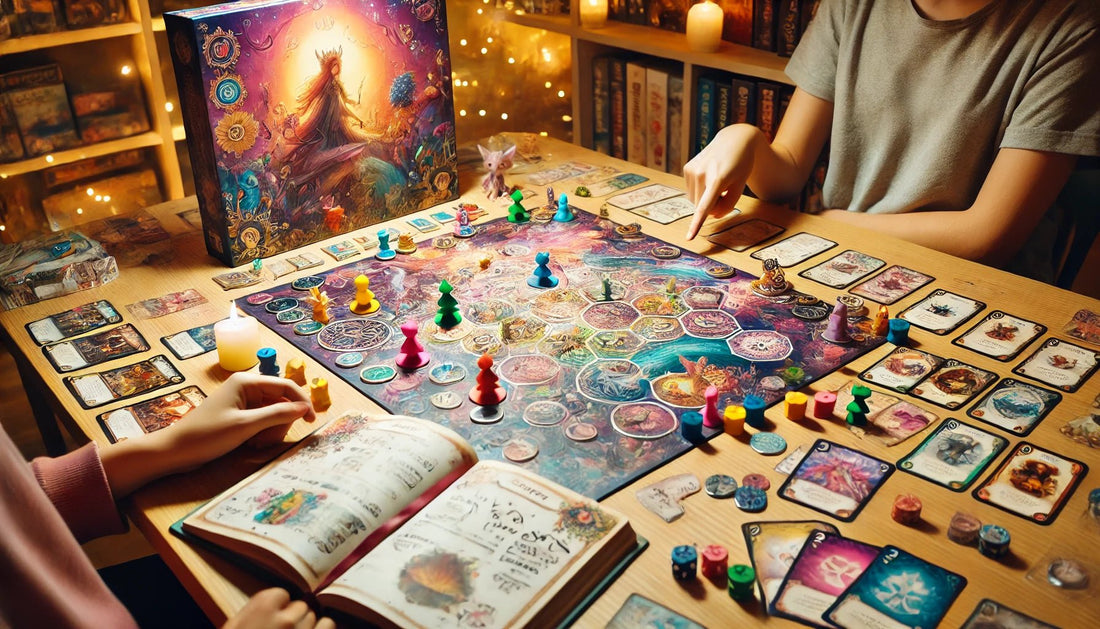
Crafting Worlds: A Whimsical Guide to Designing Your Own Board Game
Share
The Spark of Inspiration
In the heart of every great board game lies a spark of inspiration. This tiny ember, a mere flicker of an idea, can ignite a grand adventure that captivates players and weaves tales of epic proportions. Begin your journey by seeking that spark. Look around your world—what stories are waiting to be told? Perhaps it's a mystical realm of dragons and wizards, or a futuristic universe where space explorers traverse unknown galaxies. Let your imagination run wild, for this is the seed from which your game will grow.
Building Your World
Once the spark of inspiration has ignited your imagination, it's time to build the world in which your game will unfold. World-building is an art form, a dance between creativity and structure. Start by sketching out a map of your game's universe. Will your players navigate enchanted forests, ancient ruins, or bustling intergalactic marketplaces? Detail the geography, the landmarks, and the lore that breathe life into your setting.
Consider the cultures and societies that inhabit your world. What are their customs, their conflicts, their triumphs? The more depth you add to your world, the more immersive your game will become. Remember, a well-crafted world is like a character itself, full of secrets and surprises waiting to be discovered.
Crafting the Rules
Rules are the backbone of any board game, guiding players through the journey you've envisioned. Begin with the basics: how will players move, interact, and achieve their goals? Create a set of core mechanics that are easy to grasp yet challenging to master. Balance is key—your game should be engaging and fair, offering players multiple paths to victory.
As you refine your rules, consider playtesting with friends and family. Their feedback is invaluable, shedding light on potential issues and inspiring new ideas. Don't be afraid to tweak and adjust; even the most beloved games went through countless iterations before reaching perfection.
Designing Game Pieces and Cards
Now that your world and rules are taking shape, it's time to bring them to life with game pieces and cards. These tangible elements are the bridge between your imagination and your players' experience. Create characters, creatures, and artifacts that inhabit your world. Design cards that introduce events, challenges, and rewards.
Artistry plays a crucial role here. Whether you choose to illustrate the game yourself or collaborate with an artist, aim for visuals that captivate and enchant. Each piece should tell a story, drawing players deeper into the world you've crafted.
Weaving the Narrative
A great board game is more than just mechanics and pieces—it's a narrative journey. Weave a story that guides players from start to finish, filled with twists, turns, and unforgettable moments. Develop characters with rich backstories and motivations. Craft scenarios that challenge players to think strategically and work together.
Consider incorporating storytelling elements directly into the gameplay. Perhaps players uncover clues that reveal hidden aspects of the world, or encounter characters whose fates are intertwined with their own. A well-told story will linger in players' minds long after the game is over.
The Art of Playtesting
With your game designed and your narrative woven, it's time to embark on the crucial phase of playtesting. Gather a group of enthusiastic testers and watch as they navigate your world. Observe their interactions, their strategies, and their reactions. Pay attention to what works seamlessly and what needs adjustment.
Encourage open feedback and be ready to make changes. Playtesting is an iterative process, and each session brings you closer to a polished, engaging game. Embrace the unexpected—sometimes the best ideas arise from moments of spontaneity and discovery.
Bringing Your Game to Life
After countless hours of design, playtesting, and refinement, your game is ready to step into the world. Decide how you want to share your creation. Will you self-publish, launch a crowdfunding campaign, or pitch to established game publishers? Each path has its own challenges and rewards.
Create a prototype that showcases your game's best features. Develop a compelling pitch that highlights the unique aspects of your design. Network with other game designers, attend conventions, and immerse yourself in the vibrant board game community. Remember, every great game started as a dream in someone's mind.
Celebrating Your Creation
Congratulations! You've designed your own board game, a testament to your creativity and determination. Celebrate this achievement by gathering friends and family for a game night. Watch as they explore the world you've built, navigate the rules you've crafted, and immerse themselves in the narrative you've woven.
Reflect on your journey—the spark of inspiration, the hours of world-building, the thrill of playtesting. Your game is more than just a pastime; it's a story brought to life, a shared adventure that brings people together. And who knows? Perhaps this is just the beginning, the first of many worlds you'll create and share with the world.
Designing your own board game is a magical journey, one that transforms an idea into an immersive experience. With this whimsical guide, you're equipped to embark on this adventure, crafting a game that enchants and delights. So gather your imagination, your creativity, and a dash of determination, and let the world of board game design unfold before you. Happy creating!
